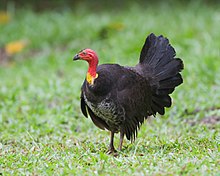Alectura lathami
| Australian brushturkey | |
|---|---|
 |
|
| Cairns, Queensland | |
| Scientific classification | |
| Kingdom: | Animalia |
| Phylum: | Chordata |
| Class: | Aves |
| Order: | Galliformes |
| Family: | Megapodiidae |
| Genus: |
Alectura Latham, 1824 |
| Species: | A. lathami |
| Binomial name | |
|
Alectura lathami Gray, 1831 |
|
| Subspecies | |
|
|
The Australian brushturkey or Australian brush-turkey (Alectura lathami), also frequently called the scrub turkey or bush turkey, is a common, widespread species of mound-building bird from the family Megapodiidae found in eastern Australia from Far North Queensland to Illawarra in New South Wales. The Australian brushturkey has also been introduced to Kangaroo Island in South Australia. It is the largest extant representative of the family Megapodiidae and is one of three species to inhabit Australia.
Despite its name and their superficial similarities, the bird is not closely related to American turkeys, nor to the Australian bustard, which is also known as the bush turkey. Its closest relatives are the wattled brushturkey, Waigeo brushturkey and malleefowl.
It is a large bird with black feathers and a red head. Its total length is about 60–75 cm (23.5–29.5 in) and a wingspan of about 85 cm (33 in). The subspecies A. l. purpureicollis from the northern Cape York Peninsula is smaller than the more widespread nominate subspecies. It has a prominent, fan-like tail flattened sideways, and its plumage is mainly blackish, but with a bare red head, and a yellow (in the nominate subspecies) or purple wattle (in A. l. purpureicollis). The male's wattle becomes much larger during breeding season, often swinging from side to side as they run. The males' heads and wattles also become much brighter during the breeding and nesting season. The underside of the body is sprinkled with white feathers, more pronounced in older birds. The brushturkey is a clumsy flier and cannot fly long distances, only taking to the air when threatened by predators or to roost in trees at night and during the heat of the day.
...
Wikipedia

